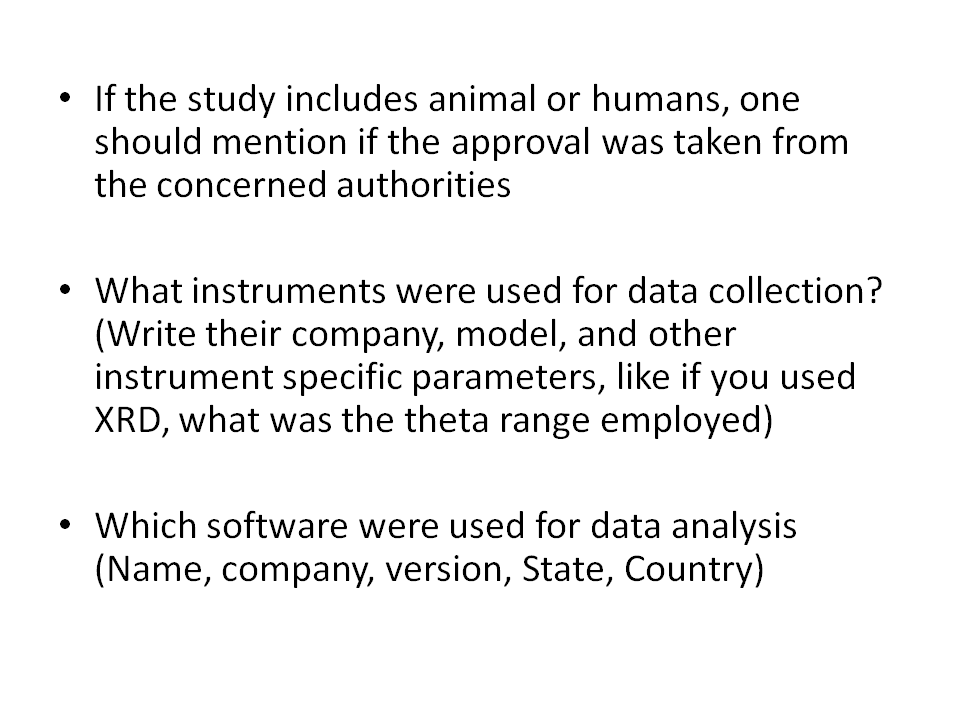Once we have decided to write on the topic of our research, the most important factor is to just begin the process. A manuscript is the first version of an article or a book before we send it for review. When I started to write the one, I thought of visiting the sites of intended journals. But there were slight variations among them and we had not finalized any particular journal.
So finally, I decided to go with the basic structure of a research article which I could edit later without much inconvenience:
- Title
- Abstract
- Introduction
- Materials and methods
- Results
- Discussions
- Conclusions
- References
But the easier way is to first identify the journal, in which you intend to publish. Visit ‘Instruction to Authors’ section on its website. This will clearly dictate the pattern for your manuscript. You may also look at the published articles from this journal to have a quick view of the layout.
When I began, I found it extremely difficult to choose a good title at the first step. The same difficulty appeared in abstract writing. So I thought to begin with the Materials and methods section.
Materials and Methods
This section is one of the most important section of a scientific manuscript. Many a times, reviewers reject a manuscript just because they are unable to understand the methodology. So, it is very important to clearly explain the whole methodology in a way that anyone who reads it, is able to reproduce the results. So, when you are writing it, write it as if you are providing a cooking recipe to your friend giving all the critical details.
So, I started writing it by answering the following questions:


It is a good strategy to break the whole section into several subsections preceded by suitable headings. One can also provide a schematic illustration to make it look attractive and easily understandable.
Completing it, I jumped to ‘Results’ section. It was the easiest section to write about as I was well acquainted with it’s how about. Working this way, things became simpler and entertaining.
Results
I began by pasting the Figures and Tables giving them suitable numbers, and proper titles (which obviously I edited later). Then I started describing each figure and table sequentially referring them with their number (as per the story of my research). I arranged the results in a sequence so as to match with what I had written in the earlier section. This is, you know, very important, as disorganized results make the reviewers and readers lose interest.
Initially I had included many tables, but later I realized that some of them were redundant. as I could replace them with the text without making it look boring or odd. And so I deleted those tables and kept only ones for which writing in text did not make any sense at all (like some were big tables, and each entry, although important, needed not be described separately).
At many occasions, I got confused whether to use a table or a graph to show my data. This is the issue I have always faced while writing any manuscript. The only way to deal with it is to look at the data and make decision following this simple rule- “A figure is useful when trends in the data are more important to communicate than the numerical values themselves.”
While working on Results section, I tried to keep a balance with number of visual aids, nor being too much neither too less. Also, I avoided using abbreviations as the courses on research methodology teach.
Also, it is important to be clear about what constitutes a significant result. What magnitude and level of result would make them ‘effective’ or ‘a success’ or ‘a demonstration of change’? And one should mention this in the manuscript very clearly. By the time, I finished the results section, I had gained a clear idea of ”What to do next?”.
References:
- O’Connor, T.R. and Holmquist, G.P. (2009), Algorithm for writing a scientific manuscript. Biochem. Mol. Biol. Educ., 37: 344-348. https://doi.org/10.1002/bmb.20329
- James M. Provenzale, Ten Principles to Improve the Likelihood of Publication of a Scientific Manuscript, American Journal of Roentgenology 2007 188:5, 1179-1182
- Shidham, V. B., Pitman, M. B., & Demay, R. M. (2012). How to write an article: Preparing a publishable manuscript!. CytoJournal, 9, 1. https://doi.org/10.4103/1742-6413.92545
4 Responses
Awesome
Thanks jyoti
It’s very useful. Thanks for providing this information.
Thanks, Pankaj. Wish you the best!